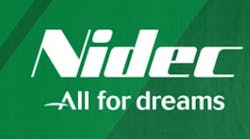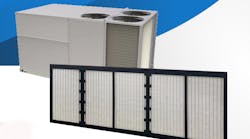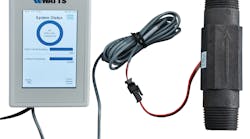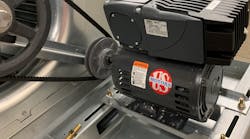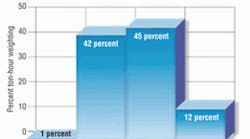Air-cooled chillers long have been the choice for system designers who are focused on simplicity and low cost. A system based on an air-cooled chiller usually is less expensive to install and easier to maintain than other types, such as water-cooled systems. On the other hand, these advantages typically have come at the expense of lower efficiency.
New technology has enabled manufacturers of air-cooled chillers to overcome this efficiency disadvantage by incorporating variable-frequency drives (VFDs) on a system’s compressors. VFDs commonly have been used on water-cooled chiller systems and recently have gained popularity on air-cooled chiller systems as the price of VFDs has decreased.
VFDs improve chiller efficiency by reducing the rotational speed of a compressor in response to off-peak, lower-load conditions. This reduction in rotational speed means the compressor does not have to work as hard; therefore, the chiller consumes far less power during off-peak conditions.
In contrast, most air-cooled chillers have non-VFD compressors that operate at constant speed, where the rotational speed of the compressor does not change, even as building load decreases. This results in inefficient, expensive operation, especially during off-peak load conditions, and less ability to accurately control chilled-water temperature.
Applications
Air-cooled chillers with compressor VFDs produce the best return on investment in applications in which there is significant operation during off-peak conditions. A typical chiller can operate up to 99 percent of the time at off-peak conditions based on ANSI/AHRI Standard 550/590, Performance Rating of Water-Chilling and Heat Pump Water-Heating Packages Using the Vapor Compression Cycle. Figure 1 provides a visual representation of how AHRI Standard 550/590 defines integrated part-load value (IPLV) based on weighted averages of weather data for 29 United States cities, building types, and operational hours of chiller plants. While IPLV should not be used to predict annual energy consumption of a chiller on its own, it is a good tool for comparing chillers.
Non-design conditions can occur when outdoor ambient temperature fluctuates or when there are large swings in building loads, such as daily occupancy shifts. Hotels, health-care facilities, office buildings, and manufacturing facilities are examples where cooling loads are not commonly at design conditions.
Financial savings through the use of VFDs are not limited to applications running at off-peak conditions. Compressor VFDs provide highly accurate water-temperature control because of their ability to adjust chiller capacity output to precisely match building load. This reduces the tendency to over- or undershoot capacity requirements, which can occur with non-VFD or constant-speed compressors. The financial benefit of this capability is that expensive storage tanks required to maintain water-temperature stability can be downsized or even eliminated. This is especially critical for applications using process cooling that require accurate water-temperature control, such as electronics manufacturing or food processing.
The Electrical Side
Additional benefits of this technology can be found on the electrical side of a system. Compressors with VFDs draw significantly less electrical current on startup than fixed-speed compressors. This characteristic minimizes the risk of nuisance trips of any sensitive electrical equipment that may be connected to the same service as the chiller. The lower electrical startup current of systems that use VFDs also can allow for downsizing of emergency power generators commonly used in mission-critical applications, such as data centers or hospitals, thereby significantly reducing the installed cost of an HVAC system.
Addition, VFDs have higher power-factor ratings—typically around 0.94 to 0.95—which can reduce utility rates in areas where the local power company assess surcharges for equipment with low power-factor ratings.
Financial Savings
The primary benefit of using an air-cooled chiller with a compressor VFD is the energy savings achieved at off-peak operating conditions. Air-cooled chillers with compressor VFDs offer as much as a 41 percent improvement in part-load efficiency compared with traditional air-cooled standard-efficiency non-VFD models, which can result in significant utility cost savings for the user (Figure 2).
The following example highlights the savings that can be realized when using an air-cooled chiller with compressor VFDs vs. a chiller without VFDs, including an energy analysis of operating hours vs. chiller load.
The Robert C. Hudson building, one of two AvMed facilities on the health-park campus in Gainesville, Fla., had a non-VFD air-cooled chiller installed in 1998 that was unreliable and inefficient. The installation required constant cooling, as approximately 10,000 sq ft of the two-story, 60,000-sq-ft building operated 24 hr a day, seven days a week.
An engineering firm hired by the local utility, Gainesville Regional Utilities (GRU), calculated that using an air-cooled chiller with VFD would reduce annual energy costs by 31 percent compared with the existing non-VFD (Figure 4) air-cooled chiller because of the significant amount of part-load operating hours, as shown in Figure 3. In fact, all operational hours for this installation are less than 100 percent design conditions.
A detailed energy analysis by the engineering firm showed a 31-percent reduction in annual energy usage, equating to $30,600 in annual energy savings (Figure 5). As a result, the customer selected a new air-cooled screw-compressor chiller with VFD to replace the older non-VFD air-cooled chiller and take advantage of energy savings and reduced electrical energy costs.
As demonstrated, the main benefits of using air-cooled chillers with compressor VFDs are realized through annual financial savings. However, air-cooled chillers with compressor VFDs typically are priced at a premium over non-VFD chillers. This price premium can be paid back or recouped in most cases through the installation and operating savings realized with this option.
Calculating Payback
Calculating the payback period to see if VFD technology is beneficial can be done using energy-analysis tools that include factors such as initial investment, annual operating costs, local climate, and operating conditions.
In regions of the country where electricity costs are high, the payback period can be less than two years. Areas with low utility rates can make the payback period longer.
Often, utility companies offer financial incentives to encourage the use of energy-saving technology, such as VFDs, and those incentives can reduce or offset the initial premium. These financial incentives come in the form of rebates or financial payments to users when they install high-efficiency chillers that meet specific efficiency targets. In some cases, the rebate opportunity can easily overcome the initial price premium for the VFD, reducing the payback period or even eliminating it.
The possible rebate received for installing an air-cooled chiller with VFD will vary based on the installation location. Returning to the example of the AvMed facility, GRU gave AvMed a rebate on the purchase of a chiller through a business rebate program started in 2007 for GRU customers who upgrade to energy-efficient equipment in their buildings. The total rebate was based on the annual amount of energy saved times 8 cents per kilowatt-hour and resulted in a $24,000 rebate for the owner.
In conclusion, air-cooled chillers with compressor VFDs have significant energy-efficiency advantages and are more affordable than ever because of high utility costs that reduce the payback period and financial rebates from utilities that encourage the use of high-efficiency chillers. Additionally, the lower maintenance and installation costs make the initial investment even more attractive.
Eddie Rodriguez is a Daikin McQuay chiller product manager. He has a bachelor’s degree in mechanical engineering from the University of Missouri-Rolla and nearly 20 years of HVAC-industry experience.



